Research on the Structure of Carbon Emission Efficiency and Influencing Factors in the Yangtze River Delta Urban Agglomeration
Abstract
:1. Introduction
2. Literature Review
- (1)
- Most of the current studies on carbon emission efficiency are conducted at national, regional, provincial, and municipal levels and at the industry level, among others. Although these studies have strong theoretical significance and practical value, it is more relevant to study the issue of carbon emissions from a specific economic and social context, taking into account regional characteristics.
- (2)
- The spatial correlation and heterogeneity of carbon emissions have been explored and revealed to a certain extent, laying a foundation for the study of regional synergy in reducing emissions. However, most of the existing literature is based on an empirical analysis of the spatial econometric models, which only empirically examine the attribute data of carbon emissions, and do not reveal the inter-regional linkage structure from the perspective of spatial correlation, while the correlation of the carbon emission efficiency between regions is rarely addressed.
- (3)
- Although the current studies on the influencing factors of carbon emission efficiency are attributed to the economic level, population size, industrial structure, energy structure, and technological progress, etc., there is no unified understanding of the specific driving effects of these influencing factors, and the influencing factors of the formation of the spatial network structure of carbon emission efficiency also need to be further studied. Only by clarifying the specific effects of these influencing factors on different regions from the perspective of spatial correlation can we correctly grasp the causes of regional differences in carbon emission efficiency and reveal the essential characteristics of regional carbon emission efficiency changes.
3. Study Area
4. Methods
4.1. Calculation of Carbon Emission Efficiency
4.2. Modified Gravity Model
4.3. Social Network Analysis Methods (SNA)
- (1)
- Overall network structure features. The overall network structure features were measured by three indicators: density, correlation degree, and efficiency of carbon emission cyberspace. Among them, the network density reflects the tightness of the whole network structure. The greater the network density, the closer the carbon emission efficiency relationship between cities. Network correlation degree reflects the connectivity between cities in a spatial network. The fewer isolated cities in the network, the greater the correlation degree of the network. Network efficiency reflects the connection efficiency between cities in the spatial correlation network. The more associations that exist between cities, the more stable the network, and the lower the network efficiency [37].
- (2)
- Node network structure features. The structure features of the node network were measured by three indexes: degree centrality, proximity centrality, and intermediary centrality. Among them, the degree centrality represents the center degree of cities in the spatial network. Intermediary centrality reflects the ability of one city to correlate with other cities. The greater the intermediary centrality, the greater the role of “intermediaries” in the network, and thus the more significant the relevance in controlling carbon emissions from other cities. The proximity centrality depicts the degree to which a city is “not controlled by other cities”. If a city has a high proximity centrality, it shows that the connection between the carbon emission efficiency of the city and other cities is mainly directly related and less controlled by other cities, and the city plays the transport function in the network.
- (3)
- Spatial clustering features. The block model is a method used to analyze the internal structure state and the position and role of each region in the plate in the social network analysis [38]. This method divides the nodes in the network into different modules by clustering, and then analyzes the interaction of each module in the spatially related network. Drawing on relevant research [39], this paper divided the spatial correlation network of carbon emission efficiency in the Yangtze River Delta urban agglomeration into four modules, “net benefit plate”, “net overflow plate”, “two-way spillover plate”, and “broker plate”, to discuss the spatial relationship of regional carbon emission efficiency.
4.4. QAP Regression Method
4.5. Data Source
5. Results and Discussion
5.1. Spatiotemporal Evolution Process of Carbon Emission Efficiency in the Yangtze River Delta Urban Agglomeration
5.1.1. Analysis of Measurement Results
5.1.2. Spatial and Temporal Evolution Process
5.2. Analysis of the Spatial Correlation Network Structure of Carbon Emission Efficiency in the Yangtze River Delta Urban Agglomeration
5.2.1. Overall Network Structure Features
5.2.2. Node Network Structure Features
- (1)
- The degree centrality. The average values of the number centrality in 2001 and 2019 were 5.385 and 5.769, respectively. The cities with larger values were Wuxi, Shanghai, Suzhou, Nanjing, and Changzhou, which had more correlations with other cities in the correlation network and occupied a dominant position in the correlation network. The cities with lower values were Taizhou, Hefei, and Anqing, which were in a subordinate position in the correlation network. Wuxi, Shanghai, Suzhou, and Nanjing, as well as other cities, were the main spillovers of carbon emission efficiency, which had a “siphon effect” on other cities [46].
- (2)
- The mean value of proximity centrality in 2001 was 56.385, which was 57 in 2019, with a small overall change. The reason for the higher proximity to the center of Taizhou, Hefei, and Anqing was that these cities were in the peripheral position in the carbon emission efficiency circle structure and the spatial structure of the Yangtze River Delta urban agglomeration; because of the influence of spatial distance and economic development, the carbon emission efficiency of these cities was controlled by other cities to a small extent, and was only correlated with neighboring cities in the periphery. Furthermore, the correlation with most nodes in the network was low, so it was necessary to improve the synergistic participation in emission reduction.
- (3)
- The intermediary centrality. The average value of intermediary centrality degree in 2001 and 2019 was 7.385 and 11.192, respectively. The leading role of the network center nodes was significantly enhanced, and the unbalanced features of the network structure were further revealed. The intermediary center of Wuxi, Shanghai, Suzhou, and Nanjing was much greater than that of other cities. These cities had strong control over the spatial correlation of the carbon emission efficiency in other cities, and had obvious “intermediary” and “bridge” roles in the spatial correlation network. The intermediary center of Taizhou, Hefei, Anqing, and other cities was maintained at a low value level, with weak control over the spatial correlation of other cities, and it was easy to change their spatial correlation in cities with high intermediary centrality. In general, the distribution of intermediary centrality among cities was extremely unbalanced, and the polarization characteristics were significant.
5.3. Spatial Clustering Features
5.4. Analysis of Influencing Factors
5.4.1. QAP Correlation Analysis
5.4.2. QAP Regression Analysis
6. Conclusions and Policy Implications
- (1)
- During the study period, the carbon emission efficiency of the Yangtze River Delta urban agglomeration as a whole showed a fluctuating downward trend, with the average value changing from 0.671 in 2001 to 0.522 in 2019. The spatial distribution gradually stabilized and showed significant spatial divergence, with the overall pattern being high in the east and low in the west. In 2019, the spatial divergence of the carbon emission efficiency of the Yangtze River Delta urban agglomeration became more obvious, and gradually formed a structural feature with southern Jiangsu as the core and declining outward, with the structural characteristics of the core decaying outward.
- (2)
- During the research period, the spatial correlation fluctuation of the carbon emission efficiency in the Yangtze River Delta urban agglomeration was enhanced, showing a complex network structure with a multi-threaded and multi-flow direction. With the evolution of time, the southern Jiangsu region as the core area, northern Zhejiang and central Jiangsu region as the sub-core area, and central Anhui and southern Zhejiang region as the edge of the core–marginal structure were gradually formed.
- (3)
- In the spatial correlation network of the carbon emission efficiency of the Yangtze River Delta urban agglomeration, the degree centrality and intermediary centrality of Shanghai, Wuxi, Nanjing, and Suzhou were much higher than those of the other 22 cities, and had a strong influence and control over the spatial correlation of the carbon emission efficiency of other cities, playing the role of the bridge and hub of network connection. In 2019, the spatial correlation of Changzhou was significantly higher, and its control power gradually emerged. Anqing, Taizhou, and other cities had a weaker correlation with the carbon emission efficiency of most cities in the network and became “islands”.
- (4)
- The 26 cities in the Yangtze River Delta urban agglomeration can be divided into four plates, “net benefit”, “net overflow”, “two-way overflow”, and “broker”, which have a strong spatial linkage effect between each plate. Shanghai, Wuxi, Nanjing, and Suzhou belong to the net beneficiary sectors, and produced a significant siphon effect on the low-carbon production factors in the surrounding cities. Changzhou, Yancheng, and other cities not only produced spillover effects to the net benefit plate and the broker plate, but also receive the spillover of the net benefit plate, which were the regulators in the network.
- (5)
- Government environmental regulation, energy efficiency, technology research and development, and economic divergence in the Yangtze River Delta urban agglomeration carbon efficiency space significantly influenced the formation of the correlation network. The energy consumption per unit GDP, industrial structure, and per-capita green space area differences on the Yangtze River Delta urban agglomeration carbon emission efficiency space correlation network structure were not significant.
- (1)
- The carbon emission efficiency of the Yangtze River Delta urban agglomeration is spatially linked, and each city’s carbon emission efficiency is not only dependent on its own development, but also influenced by other cities in its vicinity. At present, the degree of carbon emission efficiency linkage in the Yangtze River Delta urban agglomeration is relatively loose, with large disparities within the region. Therefore, local governments must deepen reforms, establish cooperation and exchange mechanisms in various areas [48], strengthen the linkage of energy conservation and emission reduction in the region through macro-control means, and continuously adjust and optimize the spatial network structure of carbon emission efficiency.
- (2)
- Each city should adopt differentiated measures according to its position in the spatial network of carbon efficiency to promote the improvement of the overall carbon efficiency of the Yangtze River Delta urban agglomeration. Shanghai, Wuxi, Suzhou, and Nanjing have a high carbon efficiency and are located at the core, but they are “net beneficiaries” and have a siphoning effect on neighboring cities. These cities should take on the responsibility of leading the region in reducing emissions and should play a leading role in providing financial, technical, and human resources support to other cities [49]. Taizhou, Hefei, Anqing, and other cities are located at the edge of the network and face the loss of carbon emission efficiency caused by the outflow of resource factors. These cities should seize the opportunity of the integration of the Yangtze River Delta; actively integrate into the carbon emission efficiency correlation network of the Yangtze River Delta urban agglomeration; introduce capital, talents, technology, and other resource factors from cities with high carbon emission efficiency; and improve their own carbon emission efficiency.
- (3)
- The formation of the spatial association of the carbon emission efficiency in the Yangtze River Delta urban agglomeration is influenced by a number of factors. These driving factors should be fully utilized to enhance the spatial association of carbon emission efficiency. On the one hand, cities should enhance the support of information and transportation networks for the circulation of carbon emission efficiency support factors, and pay attention to the optimization of energy structures and the improvement of technology levels [50]; on the other hand, they should strengthen intra-regional trade ties, bring into play the advantages of cities with a higher carbon emission efficiency in energy use and technology research, and strengthen the export of green products and technologies, so as to promote the sustainability of the region through innovation.
Author Contributions
Funding
Institutional Review Board Statement
Informed Consent Statement
Data Availability Statement
Acknowledgments
Conflicts of Interest
Appendix A
| City | 2001 | 2003 | 2005 | 2007 | 2009 | 2011 | 2013 | 2015 | 2017 | 2019 |
|---|---|---|---|---|---|---|---|---|---|---|
| Shanghai | 1.00 | 1.00 | 1.00 | 1.00 | 1.00 | 1.00 | 1.00 | 1.00 | 1.00 | 1.000 |
| Nanjing | 0.779 | 1.000 | 1.000 | 0.851 | 0.858 | 1.000 | 1.000 | 1.000 | 0.995 | 1.000 |
| Wuxi | 1.000 | 1.000 | 1.000 | 1.000 | 1.000 | 1.000 | 1.000 | 0.855 | 0.859 | 1.000 |
| Changzhou | 0.757 | 0.735 | 0.660 | 0.677 | 0.734 | 0.736 | 0.761 | 0.717 | 0.735 | 0.723 |
| Suzhou | 0.884 | 1.000 | 1.000 | 0.796 | 1.000 | 0.717 | 0.785 | 0.702 | 0.643 | 0.635 |
| Nantong | 1.000 | 0.762 | 0.683 | 0.592 | 0.640 | 0.714 | 0.704 | 0.700 | 0.710 | 0.711 |
| Yancheng | 0.347 | 1.000 | 1.000 | 1.000 | 1.000 | 0.586 | 0.491 | 0.472 | 0.465 | 0.431 |
| Yangzhou | 0.640 | 0.619 | 0.705 | 0.732 | 1.000 | 1.000 | 1.000 | 1.000 | 1.000 | 1.000 |
| Zhenjiang | 0.727 | 0.711 | 0.723 | 0.696 | 0.754 | 0.699 | 0.649 | 0.587 | 0.543 | 0.503 |
| Taizhou | 0.486 | 0.513 | 0.561 | 0.573 | 0.635 | 0.647 | 0.644 | 0.615 | 0.631 | 0.586 |
| Hangzhou | 1.000 | 1.000 | 1.000 | 1.000 | 1.000 | 1.000 | 1.000 | 1.000 | 1.000 | 1.000 |
| Ningbo | 1.000 | 0.803 | 0.745 | 0.693 | 0.749 | 0.775 | 0.795 | 0.713 | 0.703 | 0.698 |
| Jiaxing | 0.633 | 0.665 | 0.589 | 0.475 | 0.448 | 0.468 | 0.446 | 0.379 | 0.347 | 0.372 |
| Huzhou | 0.576 | 0.521 | 0.494 | 0.448 | 0.504 | 0.530 | 0.520 | 0.468 | 0.410 | 0.398 |
| Shaoxing | 0.720 | 0.676 | 0.659 | 0.617 | 0.601 | 0.645 | 0.659 | 0.594 | 0.530 | 0.536 |
| Jinhua | 0.634 | 0.552 | 0.543 | 0.491 | 0.468 | 0.474 | 0.487 | 0.444 | 0.366 | 0.345 |
| Zhoushan | 1.000 | 1.000 | 1.000 | 1.000 | 1.000 | 1.000 | 1.000 | 1.000 | 1.000 | 1.000 |
| Taizhou | 0.458 | 0.432 | 0.336 | 0.318 | 0.292 | 0.302 | 0.248 | 0.164 | 0.149 | 0.138 |
| Hefei | 0.211 | 0.217 | 0.215 | 0.228 | 0.278 | 0.200 | 0.211 | 0.235 | 0.231 | 0.303 |
| Wuhu | 0.263 | 0.280 | 0.249 | 0.269 | 0.335 | 0.235 | 0.231 | 0.198 | 0.176 | 0.174 |
| Ma’Anshan | 1.000 | 0.465 | 0.997 | 1.000 | 1.000 | 0.281 | 0.249 | 0.218 | 0.210 | 0.193 |
| Tongling | 1.000 | 1.000 | 1.000 | 1.000 | 1.000 | 1.000 | 1.000 | 0.262 | 0.251 | 0.219 |
| Anqing | 0.077 | 0.072 | 0.067 | 0.066 | 0.079 | 0.080 | 0.077 | 0.100 | 0.101 | 0.104 |
| Chuzhou | 0.112 | 0.109 | 0.097 | 0.098 | 0.110 | 0.114 | 0.118 | 0.116 | 0.112 | 0.100 |
| Chizhou | 0.999 | 1.000 | 0.172 | 0.159 | 0.179 | 0.200 | 0.214 | 0.223 | 0.211 | 0.224 |
| Xuancheng | 0.153 | 0.136 | 0.114 | 0.114 | 0.124 | 0.136 | 0.143 | 0.144 | 0.143 | 0.143 |
| Average | 0.671 | 0.664 | 0.639 | 0.611 | 0.646 | 0.598 | 0.594 | 0.535 | 0.520 | 0.521 |
Appendix B
| City | 2001 | 2019 | ||||
|---|---|---|---|---|---|---|
| Degree Centrality | Proximity Centrality | Intermediary Centrality | Degree Centrality | Proximity Centrality | Intermediary Centrality | |
| Shanghai | 16 | 42 | 46.250 | 11 | 49 | 26.781 |
| Nanjing | 6 | 51 | 3.601 | 14 | 45 | 68.464 |
| Wuxi | 18 | 38 | 79.882 | 18 | 38 | 89.495 |
| Changzhou | 6 | 50 | 1.073 | 10 | 47 | 9.853 |
| Suzhou | 15 | 42 | 30.517 | 9 | 48 | 8.493 |
| Nantong | 5 | 51 | 1.460 | 4 | 54 | 0.400 |
| Yancheng | 3 | 53 | 0.406 | 7 | 49 | 8.458 |
| Yangzhou | 6 | 50 | 1.699 | 8 | 47 | 4.327 |
| Zhenjiang | 5 | 51 | 0.573 | 2 | 55 | 0.773 |
| Taizhou | 6 | 50 | 1.699 | 6 | 50 | 4.458 |
| Hangzhou | 8 | 50 | 5.250 | 7 | 59 | 5.918 |
| Ningbo | 2 | 58 | 0.000 | 1 | 80 | 0.137 |
| Jiaxing | 4 | 52 | 0.960 | 6 | 49 | 6.740 |
| Huzhou | 4 | 52 | 0.960 | 6 | 49 | 6.740 |
| Shaoxing | 4 | 52 | 0.960 | 4 | 56 | 1.793 |
| Jinhua | 4 | 52 | 0.960 | 4 | 56 | 1.793 |
| Zhoushan | 5 | 51 | 6.193 | 3 | 57 | 23.275 |
| Taizhou | 0 | 100 | 0.000 | 0 | 150 | 0.000 |
| Hefei | 0 | 100 | 0.000 | 1 | 68 | 0.146 |
| Wuhu | 1 | 59 | 0.000 | 2 | 55 | 0.773 |
| Ma’Anshan | 5 | 51 | 0.606 | 3 | 54 | 1.106 |
| Tongling | 3 | 54 | 0.200 | 6 | 49 | 6.149 |
| Anqing | 0 | 100 | 0.000 | 1 | 68 | 0.125 |
| Chuzhou | 2 | 57 | 0.000 | 4 | 53 | 1.249 |
| Chizhou | 7 | 49 | 6.677 | 6 | 49 | 6.149 |
| Xuancheng | 5 | 51 | 2.073 | 7 | 48 | 7.812 |
| Average | 5 | 56 | 7.385 | 5.769 | 57 | 11.192 |
References
- Su, Y.; Chen, X.; Ye, Y.; Wu, Q.; Zhang, H.; Huang, N.; Kuang, Y. Characteristics and mechanism of energy consumption in China based on night lighting data. J. Geogr. 2013, 68, 1513–1526. [Google Scholar]
- Liu, Q.; Wang, S.; Zhang, W.; Li, J.; Kong, Y. Examining the effects of income inequality on CO2 emissions: Evidence from non-spatial and spatial perspectives. Appl. Energy 2019, 236, 163–171. [Google Scholar] [CrossRef]
- Liu, Z.; Chen, L. Demonstration value and dynamic mechanism of regional integration development of the Yangtze River Delta. Reform 2018, 65–71. Available online: https://kns.cnki.net/kcms/detail/detail.aspx?dbcode=CJFD&dbname=CJFDLAST2019&filename=REFO201812006&uniplatform=NZKPT&v=3HzzqpA_AsORVP5FzlwfgPZBL5PJkQbSMrejO4VToCA43Zv9M1d3zf5-GHQzBhOn (accessed on 20 March 2022).
- Zhang, G.; Wang, J.; Wu, K.; Xu, Z. Spatiotemporal characteristics and influencing factors of economic and environmental coordination among the three major urban agglomerations in China. Geogr. Res. 2020, 39, 272–288. [Google Scholar]
- Liu, Z.; Geng, Y.; Xue, B.; Xi, F.; Jiao, J. A calculation method of CO2 emission from urban energy consumption. Resour. Sci. 2011, 33, 1325–1330. [Google Scholar]
- Zhao, R.; Huang, X.; Peng, B. Research on carbon cycle and carbon balance of Nanjing urban system. Acta Geogr. Sin. 2012, 67, 758–770. [Google Scholar]
- Xu, S.; Xi, R.; He, Z. Influential factors and policy implications of carbon emissions for energy consumption in China. Resour. Sci. 2012, 34, 2–12. [Google Scholar]
- Li, J.; Huang, X.; Chuan, X.; Sun, S. Analysis of the spatio-temporal characteristics and influencing factors of carbon emission efficiency in the Yangtze River Delta region. Resour. Environ. Yangtze River Basin 2020, 29, 1486–1496. [Google Scholar]
- Zhao, R.; Huang, X.; Zhong, T. Research on carbon emission intensity and carbon footprint of different industrial spaces in China. Acta Geogr. Sin. 2010, 65, 1048–1057. [Google Scholar]
- Chen, H.; Qi, S.; Tan, X. Decomposition and prediction of China’s carbon emission intensity towards carbon neutrality: From perspectives of national, regional and sectoral level. Sci. Total Environ. 2022, 8, 5–18. [Google Scholar] [CrossRef]
- Fang, G.; Gao, Z.; Tian, L.; Fu, M. What drives urban carbon emission efficiency?—Spatial analysis based on nighttime light data. Appl. Energy 2022, 312, 118772. [Google Scholar] [CrossRef]
- Xu, Q.; Zhong, M.; Cao, M. Does digital investment affect carbon efficiency? Spatial effect and mechanism discussion. Sci. Total Environ. 2022, 3, 4–25. [Google Scholar] [CrossRef] [PubMed]
- Kaya, Y.; Yokobori, K. Global Environment, Energy and Economic Development; United Nations University: Tokyo, Japan, 1993. [Google Scholar]
- Sun, J.W. The decrease of CO2 emission intensity is decarbonization at national and global levels. Energy Policy 2005, 33, 957–978. [Google Scholar] [CrossRef]
- Mielnik, O.; Goldemberg, J. Communication the evolution of the Carbon Index in developing countries. Energy Policy 1999, 27, 307–318. [Google Scholar] [CrossRef]
- Ang, B.W. Is the energy intensity a less useful indicator than the carbon factor in the study of climate change. Energy Policy 1999, 27, 943–946. [Google Scholar] [CrossRef]
- Ramanathan, V. Combining indicators of energy consumption and CO2 emissions: Across country comparison. Int. J. Glob. Energy Issues 2002, 17, 214–227. [Google Scholar] [CrossRef]
- Zaim, O.; Taskin, F. Environmental efficiency in carbon dioxide emissions in the OECD: A non-parametric approach. J. Environ. Manag. 2000, 58, 95–107. [Google Scholar] [CrossRef]
- Wang, K.; Shao, H.; Zhou, T.; Liu, H. Carbon emission efficiency and its spatial correlation characteristics of Chinese tourism industry. Resour. Environ. Yangtze River Basin 2018, 27, 473–482. [Google Scholar]
- Dwyer, L.; Forsyth, P.; Spurr, R.; Hoque, S. estimating the carbon footprint of Australian tourism. J. Sustain. Tour. 2010, 18, 355–376. [Google Scholar] [CrossRef]
- Hampf, B.; Rødseth, K.L. Carbon dioxide emission standards for U.S. power plants: An efficiency analysis perspective. Energy Econ. 2015, 50, 140–153. [Google Scholar] [CrossRef] [Green Version]
- Erwin, S.; Ridha, S.; Tubandryah, H. Determinants of Carbon Emission Disclosure in Indonesia Manufacturing Company. Asian J. Econ. Bus. Account. 2021, 22, 1–9. [Google Scholar] [CrossRef]
- Zhang, Z.Q.; Zhang, T.; Feng, D.F. Regional differences, dynamic evolution and convergence of carbon emission intensity in China. Res. Quant. Econ. Technol. 2022, 39, 67–87. [Google Scholar]
- Meng, M.; Fu, Y.; Wang, T.; Jing, K. Analysis of low-carbon economy efficiency of Chinese industrial sectors based on a RAM model with undesirable outputs. Sustainability 2017, 9, 451. [Google Scholar] [CrossRef] [Green Version]
- Zheng, H.; Ye, A. The spatial correlation network structure of carbon emission in the Pearl River Delta urban agglomeration. Environ. Sci. China 2022, 4, 1–13. [Google Scholar]
- Li, A.; Wang, Y.; Li, M.; Wang, B.; Chen, W. Study on the structural characteristics and influencing factors of the spatial correlation network of carbon emission: Take the three major urban agglomerations in China as an example. Environ. Sci. Technol. 2021, 44, 186–193. [Google Scholar]
- Grunewald, N.; Jakob, M.; Mouratiadou, I. Decomposing inequality in CO2 emissions: The role of primary energy carriers and economic sectors. Ecol. Econ. 2014, 100, 183–194. [Google Scholar] [CrossRef] [Green Version]
- Marbuah, G.; Amuakwa-Mensah, F. Spatial analysis of emissions in Sweden. Energy Econ. 2017, 68, 383–394. [Google Scholar] [CrossRef] [Green Version]
- Wu, H. Chinese provincial carbon emission reduction: Spatiotemporal pattern, evolution mechanism and policy Suggestions—Is based on the theory and method of spatial econometrics. Manag. World 2015, 3–10. [Google Scholar] [CrossRef]
- Zhou, C.; Wang, S. Examining the determinants and the spatial nexus of city-level CO2 emissions in China: A dynamic spatial panel analysis of China’s cities. J. Clean. Prod. 2018, 171, 917–926. [Google Scholar] [CrossRef]
- Wang, K.; Wu, M.; Sun, Y.P.; Shi, X.; Sun, A.; Zhang, P. Resource abundance, industrial structure, and regional carbon emissions efficiency in China. Resour. Policy 2019, 60, 203–214. [Google Scholar] [CrossRef]
- Liu, B.; Tian, C.; Li, Y.; Song, H.; Ma, Z. Research on the effects of urbanization on carbon emissions efficiency of urban agglomerations in China. J. Clean. Prod. 2018, 197, 1374–1381. [Google Scholar] [CrossRef]
- Zhou, P.; Ang, B.W.; Poh, K.L. Slacks-based efficiency measures for modeling environmental performance. Ecol. Econ. 2010, 60, 111–118. [Google Scholar] [CrossRef]
- Ma, Y.; Lu, Y. Different sources of technological advances and carbon dioxide emission efficiency—Based on space panel data model empirical. Res. Dev. Manag. 2017, 29, 33–41. [Google Scholar]
- Sun, H.; Yang, X.; Leng, Z. Research on the spatial effects of haze pollution on public health: Spatial–temporal evidence from the Yangtze River Delta urban agglomerations, China. Environ. Sci. Pollut. Res. 2022. prepublish. [Google Scholar] [CrossRef] [PubMed]
- Wang, S.; Gao, S.; Huang, Y.; Shi, C. Spatiotemporal evolution pattern and prediction of Chinese urban carbon emission performance based on ultra-efficiency SBM model. J. Geogr. 2020, 75, 1316–1330. [Google Scholar]
- Tone, K. A slacks-based measure of efficiency in data envelopment analysis. Eur. J. Oper. Res. 2001, 130, 498–509. [Google Scholar] [CrossRef] [Green Version]
- Wang, X.; Feng, Q.; Song, J. Evolution and influencing factors of carbon emission space correlation structure in Chengdu-Chongqing urban agglomeration. China Environ. Sci. 2020, 40, 4123–4134. [Google Scholar]
- Zhao, L.; Gao, X.; Liu, Y.; Han, Z. Analysis of the structural evolution characteristics of the inclusive green efficiency spatial correlation network in China. Econ. Geogr. 2021, 41, 69–78, 90. [Google Scholar]
- Wasserman, S.; Faust, K. Social network analysis: Methods and applications. Contemp. Soc. 1994, 91, 219–220. [Google Scholar]
- Wang, S.; Huang, Y. Spatial spillover effect and drivers of urban carbon emission intensity in China. J. Geogr. 2019, 74, 1131–1148. [Google Scholar]
- Zhang, X.; Liao, K.; Zhou, X. Analysis of regional differences and dynamic mechanisms of agricultural carbon emission efficiency in China’s seven agricultural regions. Environ. Sci. Pollut. Res. Int. 2022, 29, 38258–38284. [Google Scholar] [CrossRef]
- Shang, J.; Ji, X.; Shi, R.; Zhu, M. Structure and driving factors of agricultural carbon emission Efficiency in China. Chin. J. Ecol. Agric. 2021, 12, 1–16. [Google Scholar]
- Su, Y. Research on Carbon Emissions of Energy Consumption in China Based on DMSP/OLS Night Light Data. Grad. Sch. Chin. Acad. Sci. (Guangzhou Inst. Geochem.) 2015. (In Chinese). Available online: https://kns.cnki.net/kcms/detail/detail.aspx?dbcode=CDFD&dbname=CDFDLAST2015&filename=1015361462.nh&uniplatform=NZKPT&v=bI9k706Kl1ZrLOjSE9IwRvCSAZnZTLwOshGiEOoQvspGMrttvF3ugXqWbkgzJsu1 (accessed on 22 March 2022).
- Wang, C.; Padmanabhan, P.; Huang, C.H. The impacts of the 1997 Asian financial crisis and the 2008 global financial crisis on renewable energy consumption and carbon dioxide emissions for developed and developing countries. Heliyon 2022, 8, e08931. [Google Scholar] [CrossRef] [PubMed]
- Zhou, Z.; Cao, L.; Zhao, K.; Li, D.; Ding, C. Spatio-Temporal Effects of Multi-Dimensional Urbanization on Carbon Emission Efficiency: Analysis Based on Panel Data of 283 Cities in China. Int. J. Environ. Res. Public Health 2021, 18, 12712. [Google Scholar] [CrossRef] [PubMed]
- Lu, Y.; Li, M. Industrial Carbon Emission Efficiency in the Yangtze River Economic Belt and Its Influencing Factors. Int. J. Des. Nat. Ecodyn. 2020, 15, 25–32. [Google Scholar] [CrossRef] [Green Version]
- Chen, L.; Liu, Y.; Gao, Y.; Wang, J. Carbon Emission Trading Policy and Carbon Emission Efficiency: An Empirical Analysis of China’s Prefecture-Level Cities. Front. Energy Res. 2021, 844. [Google Scholar] [CrossRef]
- Guo, Y.; Cao, X.; Wei, W.; Zeng, G. Study on the Impact of Regional Integration of the Yangtze River Delta on Urban Carbon Emissions. Geogr. Res. 2022, 41, 181–192. [Google Scholar]
- Xue, L.M.; Zheng, Z.X.; Meng, S.; Li, M.; Li, H.; Chen, J.M. Carbon emission efficiency and spatio-temporal dynamic evolution of the cities in Beijing-Tianjin-Hebei Region, China. Environ. Dev. Sustain. 2021, 24, 7640–7664. [Google Scholar] [CrossRef]

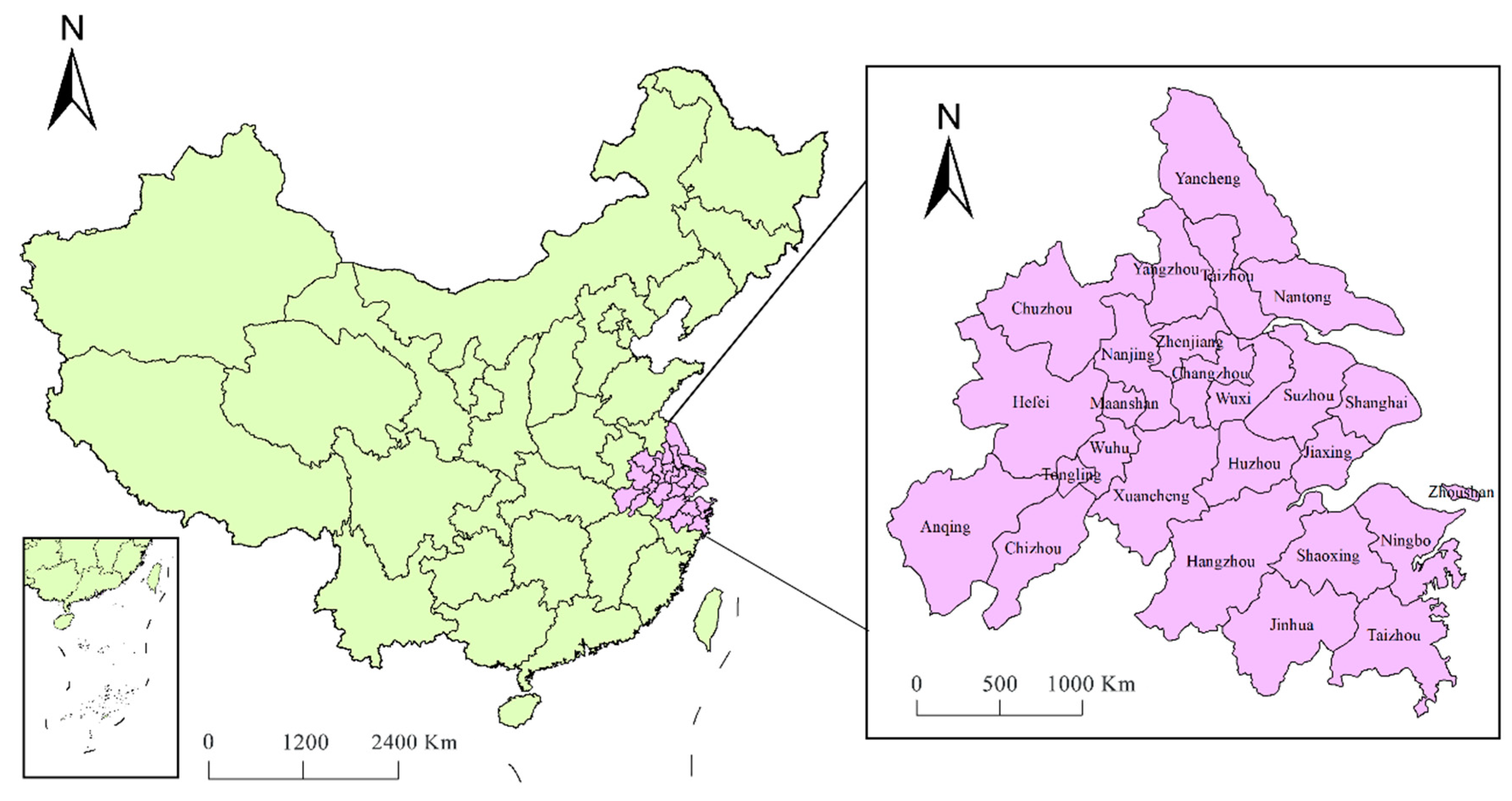
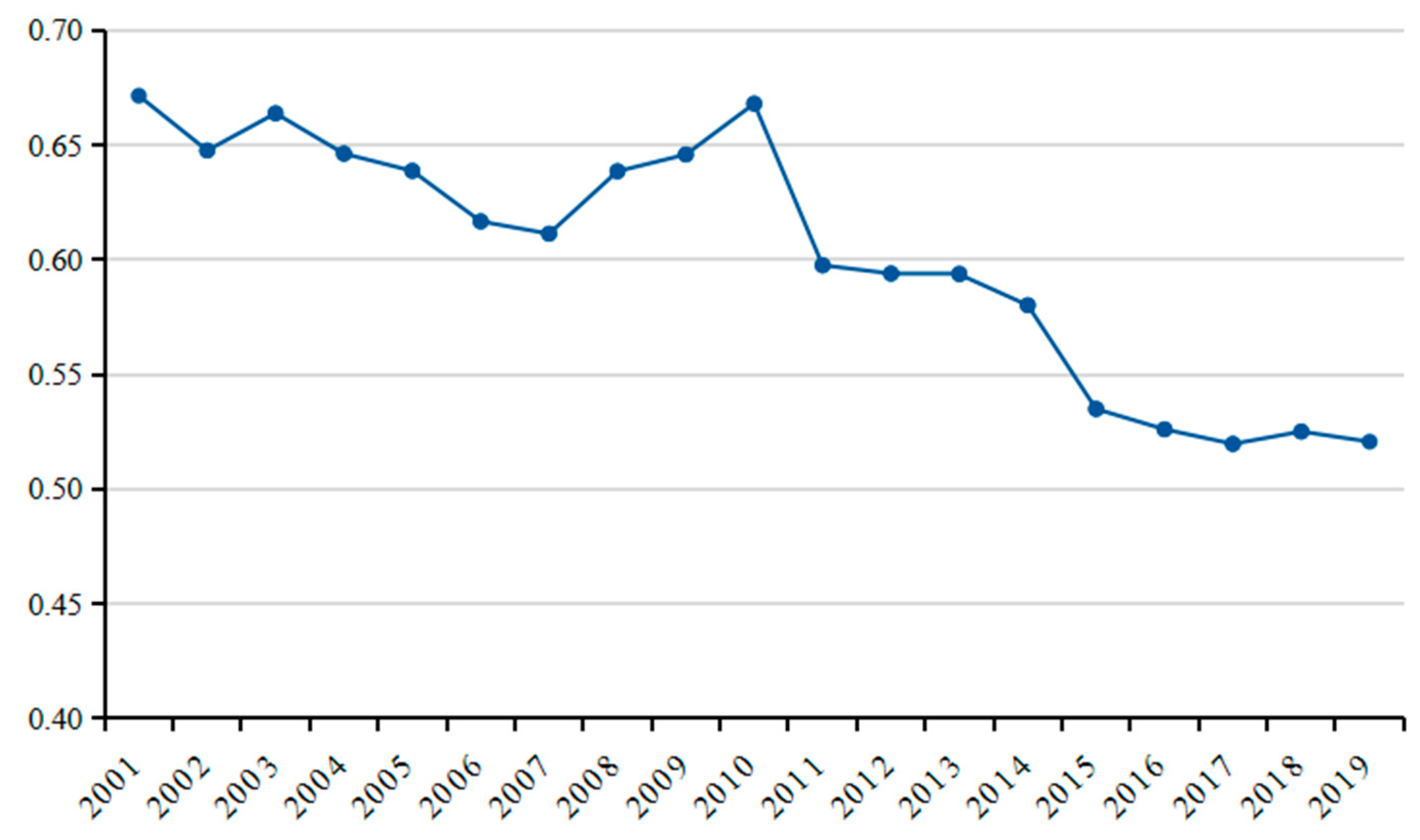
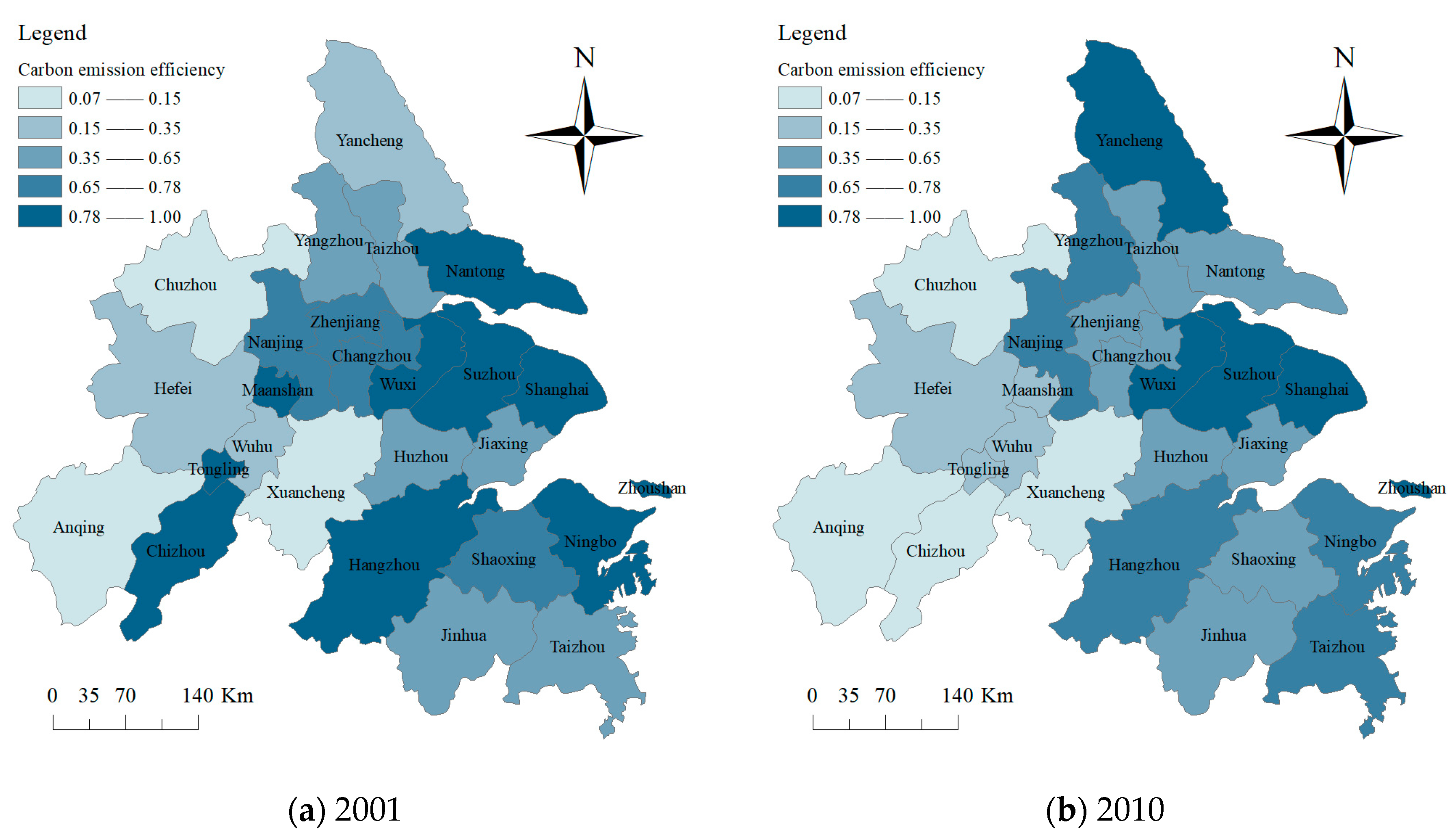
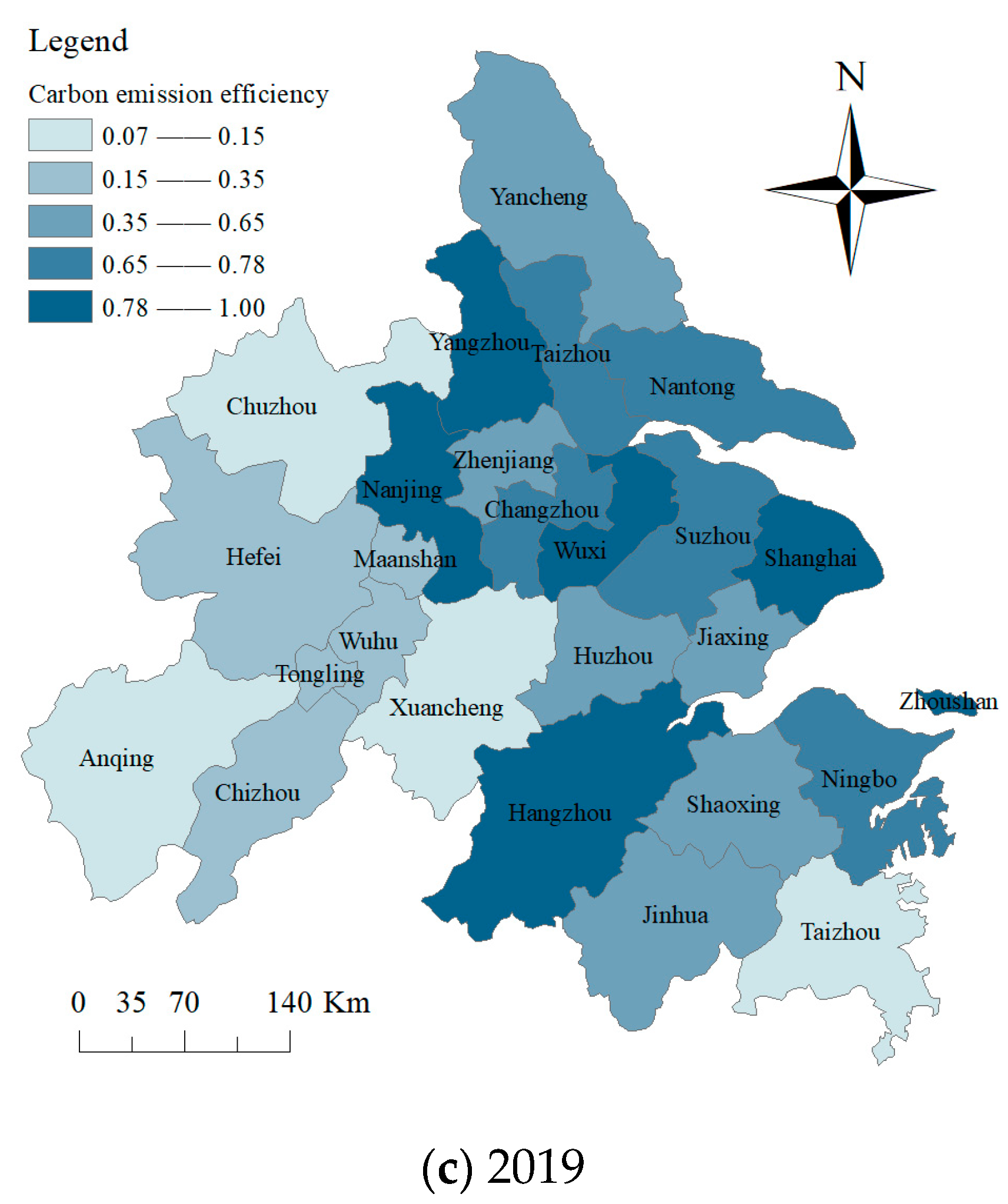
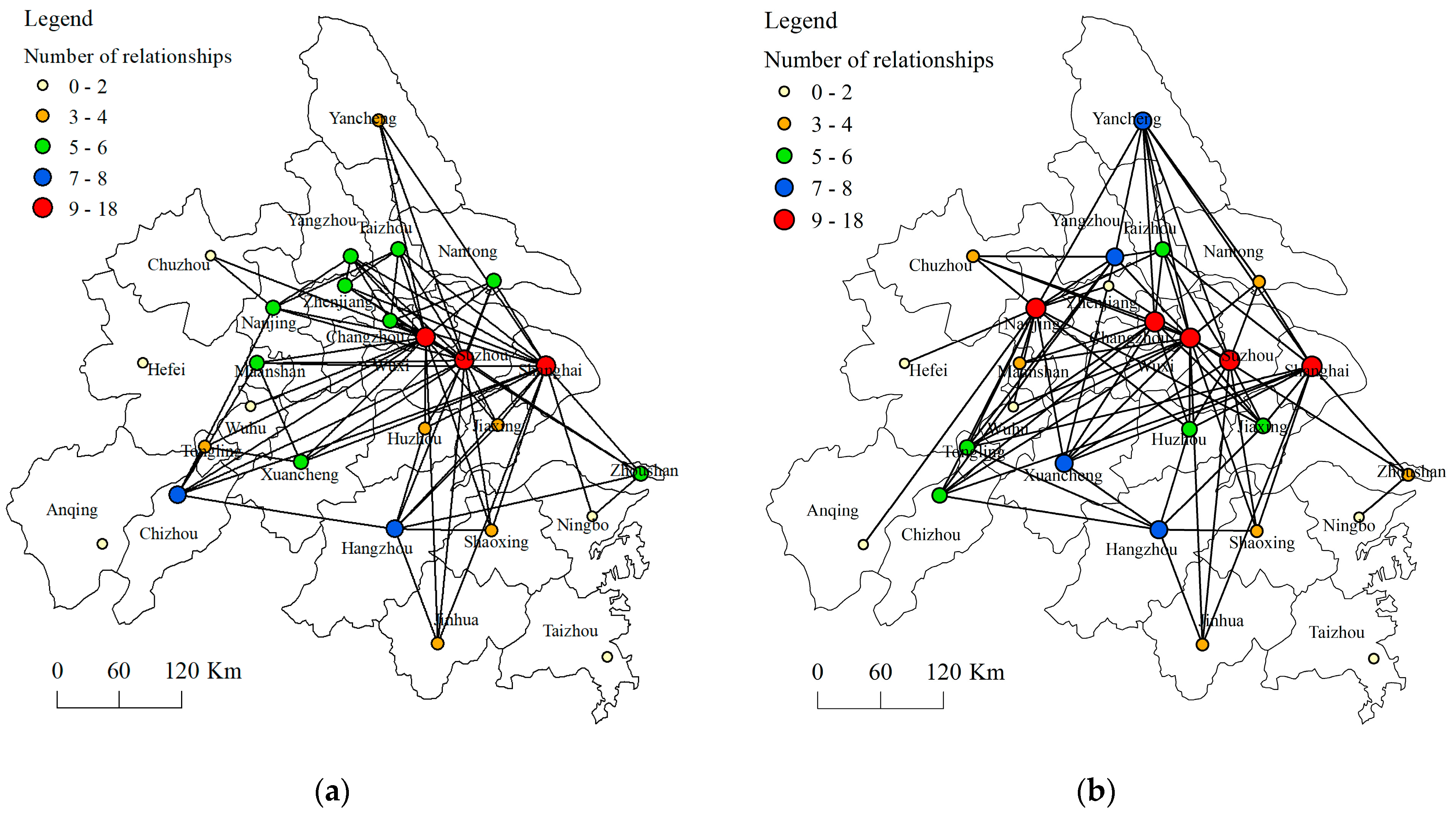

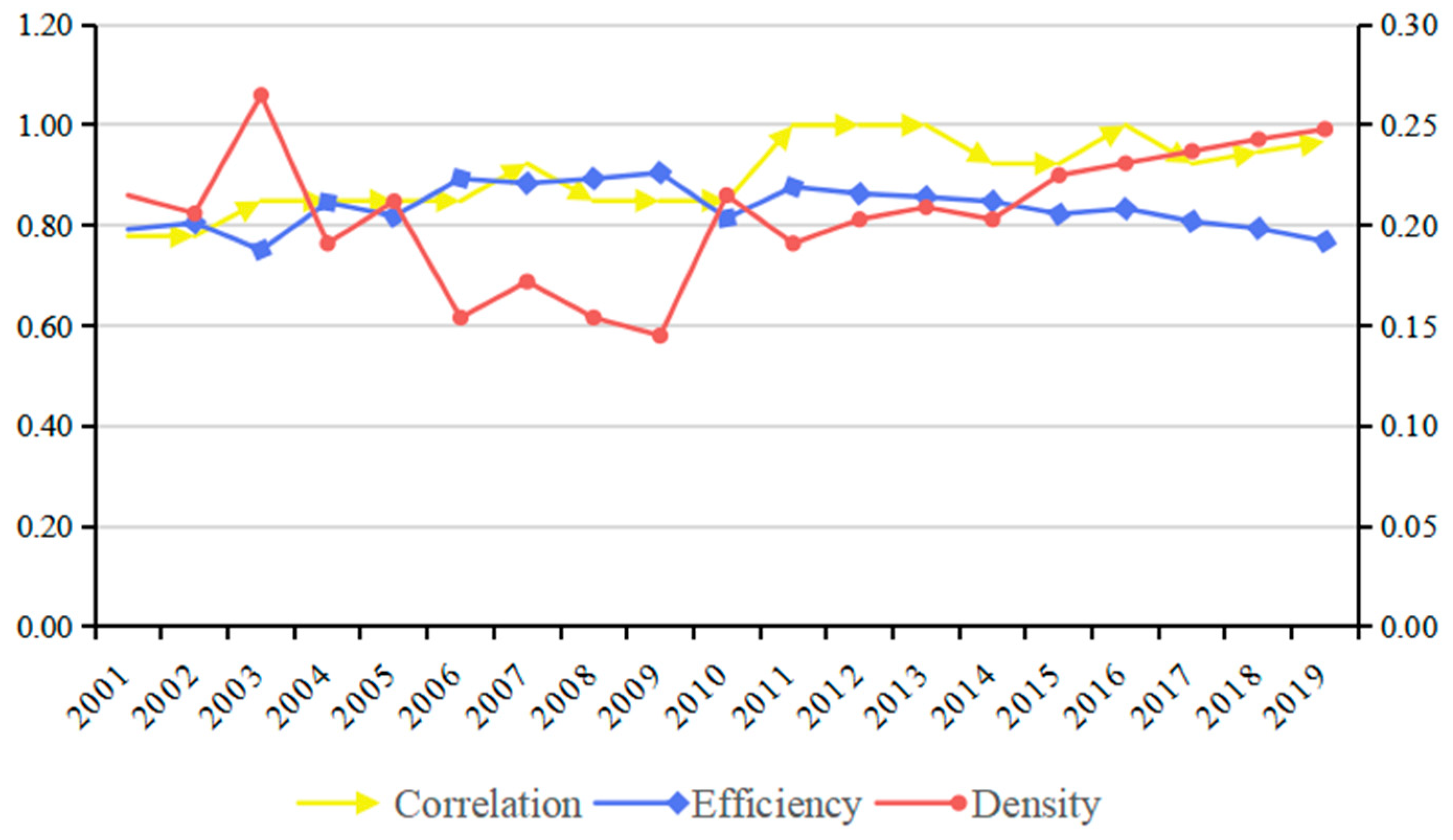

| Index | Variable | Unit |
|---|---|---|
| Investment index | Investment in the fixed assets | CNY 100 million |
| Employee | Thousands of people | |
| Electricity consumption | One hundred million kilowatt-hours | |
| Expect output | GDP | CNY 100 million |
| Undesired output | Energy carbon emissions | Ten thousand tons |
| Variable | Meaning | Index |
|---|---|---|
| E | Differences in energy resource structure | The difference in coal consumption in total energy consumption (%) |
| G | Differences in environmental regulation | The difference in proportion of inter-urban government fiscal expenditure in GDP (%) |
| F | Differences in energy intensity | The difference between per unit of GDP (ton of standard coal/CNY 10,000) |
| P | Differences in industrial structure | The difference between the output value of the secondary industry between cities (%) |
| T | Differences in technical level | The difference between R&D expenditure (CNY 10,000) |
| R | Differences in carbon sink efficiency | The difference between per capita green area (ten thousand people/m2) |
| O | Differences in external contact | The difference between total import and export trade between cities (CNY 100 million) |
| Position | 2001 | 2019 |
|---|---|---|
| Core (number of associations ≥ 10) | Wuxi, Shanghai, and Suzhou | Shanghai, Wuxi, Nanjing, and Changzhou |
| Secondary core (number of associations ∈ [5, 10)) | Hangzhou, Chizhou, Nanjing, Changzhou, Yangzhou, Taizhou, Nantong, Zhenjiang, Zhoushan, Ma’Anshan, and Xuancheng | Suzhou, Yangzhou, Yancheng, Hangzhou, Xuancheng, Taizhou, Jiaxing, Huzhou, Tongling, and Chizhou |
| Secondary edge (number of associations ∈ [3, 5)) | Jiaxing, Huzhou, Shaoxing, Jinhua, Yancheng, and Tongling | Nantong, Shaoxing, Jinhua, Chuzhou, Zhoushan, and Ma’Anshan |
| Edge (number of associations ≤ 2) | Ningbo, Chuzhou, Wuhu, Taizhou, Hefei, and Anqing | Zhenjiang, Hefei, Anqing, Taizhou, Wuhu, and Ningbo |
| Plate Type | City | Total Number of Accepted Relationships | Total Number of Overflow Relationships | Expected Internal Relationship Ratio | Actual Internal Relationship Ratio | ||
|---|---|---|---|---|---|---|---|
| Within the Plate | Outside the Plate | Within the Plate | Outside the Plate | ||||
| Plate I | Shanghai, Wuxi, Suzhou, and Nanjing | 5 | 84 | 3 | 20 | 16.26 | 13.04 |
| Plate II | Changzhou, Yancheng, Hangzhou, Yangzhou, Xuancheng, Huzhou, Taizhou, and Shaoxing | 21 | 26 | 27 | 36 | 48.90 | 42.86 |
| Plate III | Nantong, Jiaxing, Jinhua, Zhoushan, Tongling, Maanshan, and Ningbo | 16 | 17 | 11 | 55 | 34.17 | 16.67 |
| Plate IV | Zhenjiang, Hefei, Anqing, Taizhou, Chizhou, Wuhu, and Chuzhou | 3 | 18 | 4 | 34 | 12.14 | 10.53 |
| Variable | Correlation Analysis | Regression Analysis | ||
|---|---|---|---|---|
| Coefficient | p-Value | Coefficient | p-Value | |
| Differences in energy resource structure | −0.037 | 0.202 | −0.003 | 0.158 |
| Differences in environmental regulation | 0.378 *** | 0.003 | 0.282 ** | 0.004 |
| Differences in energy consumption per unit of GDP | 0.292 ** | 0.038 | 0.224 ** | 0.035 |
| Differences in secondary industry | −0.072 | 0.202 | −0.004 | 0.160 |
| Differences in R&D spending | 0.392 ** | 0.002 | 0.300 ** | 0.003 |
| Differences in per-capita green space area | −0.004 | 0.328 | 0.012 | 0.153 |
| Differences in total import and export trade | 0.353 ** | 0.023 | 0.259 ** | 0.033 |
Publisher’s Note: MDPI stays neutral with regard to jurisdictional claims in published maps and institutional affiliations. |
© 2022 by the authors. Licensee MDPI, Basel, Switzerland. This article is an open access article distributed under the terms and conditions of the Creative Commons Attribution (CC BY) license (https://creativecommons.org/licenses/by/4.0/).
Share and Cite
Liu, C.; Tang, R.; Guo, Y.; Sun, Y.; Liu, X. Research on the Structure of Carbon Emission Efficiency and Influencing Factors in the Yangtze River Delta Urban Agglomeration. Sustainability 2022, 14, 6114. https://doi.org/10.3390/su14106114
Liu C, Tang R, Guo Y, Sun Y, Liu X. Research on the Structure of Carbon Emission Efficiency and Influencing Factors in the Yangtze River Delta Urban Agglomeration. Sustainability. 2022; 14(10):6114. https://doi.org/10.3390/su14106114
Chicago/Turabian StyleLiu, Chenxu, Ruien Tang, Yaqi Guo, Yuhan Sun, and Xinyi Liu. 2022. "Research on the Structure of Carbon Emission Efficiency and Influencing Factors in the Yangtze River Delta Urban Agglomeration" Sustainability 14, no. 10: 6114. https://doi.org/10.3390/su14106114
APA StyleLiu, C., Tang, R., Guo, Y., Sun, Y., & Liu, X. (2022). Research on the Structure of Carbon Emission Efficiency and Influencing Factors in the Yangtze River Delta Urban Agglomeration. Sustainability, 14(10), 6114. https://doi.org/10.3390/su14106114





